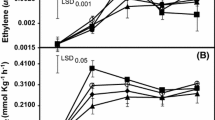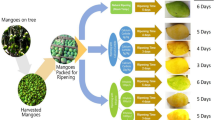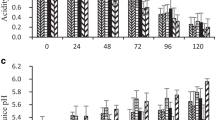Abstract
During ripening, fleshy fruits undergo textural changes that lead to loss of tissue firmness and consequent softening due to cell wall dismantling carried out by different and specifically expressed enzymes. The effect of various chemical treatments on the ripening of mango fruit (Mangifera indica) was investigated at physiological and biochemical level. Based on changes in respiration, firmness, pH, total soluble sugar and a cell wall degrading enzyme pectate lyase (PEL) activity, treatment with 1-methylcyclopropene (1-MCP), silver nitrate (AgNO3), gibberlic acid (GA3), sodium metabisulphite (SMS) and ascorbic acid led to delaying of ripening process while those of ethrel and calcium chloride (CaCl2) enhanced the process. PEL of mango was found to be inhibited by certain metabolites present in dialysed ammonium sulphate enzyme extract as well as EDTA. Mango PEL activity exhibited an absolute requirement for Ca2+ and an optimum pH of 8.5.


Similar content being viewed by others
References
Abeles FB, Morgan PW, Saltveit ME (1992) Ethylene in plant biology, 2nd edn. Academic, New York
AOAC (1980) Official methods of analysis, 13th edn. Association of Official Analytical Chemists, Washington, DC
Baritelle AL, Hyde GM, Fellman JK, Varith J (2001) Using 1-MCP to inhibit the influence of ripening on impact properties of pear and apple tissue. Postharvest Biol Technol 23:153–160
Ben-Arie R, Saks Y, Sonego L, Frank A (1995) Cell wall metabolism in gibberellins treated persimmon fruits. Plant Growth Regul 19:25–33
Bradford MM (1976) A rapid and sensitive method for the quantitation of microgram quantities of protein utilizing the principle of protein–dye binding. Anal Biochem 72:248–254
Bruhlmann F (1995) Purification and characterization of an extracellular pectate lyase from an Amycolata sp. Appl Environ Microbiol 61:3580–3585
Castillejo C, de la Fuente JI, Lannetta P, Botella MA, Valpuesta V (2004) Pectin esterase gene family in strawberry fruit: study of FaPE1, a ripening-specific isoform. J Exp Bot 55(398):909–918
Chang WH, Hwang YJ (1990) Effect of ethylene treatment in ripening, polyphenol oxidase activity and water soluble tannin content of Taiwan northern banana at different maturity stages and the stability of the banana polyphenoloxidase. Acta Hortic 275:603–610
Collmer A, Reid JL, Mount MS (1988) Assay methods for pectic enzymes. Methods in enzymology, vol 161. Academic, San Diego, pp 329–335
Dong L, Lurie S, Zhou H (2002) Effect of 1-methylcyclopropene on ripening of ‘Canino’ apricots and ‘Royal Zee’ plums. Postharvest Biol Technol 24:135–145
Edwards JI, Saltveit ME, Henderson WR (1983) Inhibition of lycopene svnthesis in tomato pericarp tissue by inhibitors of ethylene biosynthesis and reversal with applied ethylene. J Am Soc Hortic Sci 108:512–514
Fan X, Argenta L, Mattheis JP (2000) Inhibition of ethylene action by 1-methylcyclopropene prolongs storage life of apricots. Postharvest Biol Technol 20:135–142
Feng X, Apelbaum A, Sisler EC, Goren R (2000) Control of ethylene responses in avocado fruit with 1-methylcyclopropene. Postharvest Biol Technol 20:143–150
Feng X, Apelbaum A, Sisler EC, Goren R (2004) Control of ethylene activity in various plant systems by structural analogues of 1-methylcyclopropene. Plant Growth Regul 42:29–38
Giavanonni J (2001) Molecular biology of fruit maturation and ripening. Annu Rev Plant Physiol Mol Biol 52:725–749
Gorny JR, Hess-Pierce B, Cifuentes RA, Kader AA (2002) Quality changes in fresh-cut pear slices as affected by controlled atmospheres and chemical preservatives. Postharvest Biol Technol 24:271–278
Hoeberichts FA, Van Der Plas LHW, Woltering EJ (2002) Ethylene perception is required for expression of tomato ripening-related genes and associated physiological changes even at advanced stages of ripening. Postharvest Biol Technol 26:125–133
Hofmann MH (2002) Biogeography of Arabidopsis thaliana (L) Heynh. (Brassicaceae). J Biogeogr 29:125–134
Klee H, Tieman D (2002) The tomato ethylene receptor gene family: form and function. Physiol Planta 115:336–341
Klee HJ (2002) Control of ethylene-mediated processes in tomato at the level of receptors. J Exp Bot 53:2057–2063
Koornneef M, Fransz P, Dejong H (2003) Cytogenetic tools for Arabidopsis thaliana. Chromosome Res 11:183–194
Liberman M, Baker JE, Sloger M (1977) Influence of plant hormones on ethylene production in apple, tomato and avocado slices during maturation and senescence. Plant Physiol 60:214–217
Martínez PG, Gómez RL, Gómez-Lim MA (2001) Identification of an ETR1-homologue from mango fruit expressing during fruit ripening and wounding. J Plant Physiol 158(1):101–108
Mordy A, Saltveit ME, Hobson GE (1987) Effect of silver ions on ethylene biosynthesis by tomato fruit tissue. Plant Physiol 83:44–48
Mostolfi Y, Toivonen PMA, Lessani H, Babalar M, Lu C (2003) Effects of 1-methylcyclopropene on ripening of greenhouse tomatoes at three storage temperatures. Postharvest Biol Technol 27:285–292
Nakatsuka A, Murachi S, Okonushi H, Shiomi S, Nakano R, Kubo Y, Inaba A (1998) Differential expression and internal feedback regulation of 1-aminocyclopropane-1-carboxylate synthase, 1-aminocyclopropane-1-carboxylate oxidase, and ethylene receptor genes in tomato fruit during development and ripening. Plant Physiol 118:1295–1305
Nakatsuka A, Shiomi S, Kubo Y, Inaba A (1997) Expression and internal feedback regulation of ACC synthase and ACC oxidase genes in ripening tomato fruit. Plant Cell Physiol 38:1103–1110
Pathak N, Sanwal GG (1998) Multiple forms of polygalacturonase from banana fruits. Phytochemistry 48:249–255
Payasi A, Sanwal GG (2003) Pectate lyase activity during ripening of banana fruit. Phytochemistry 63:243–248
Porat RW, Cohen B, Daus L, Goren A, Droby S (1999) Effects of ethylene and 1-methylcyclopropene on the postharvest qualities of ‘Shamouti’ oranges. Postharvest Biol Technol 15:155–163
Rasori A, Ruperti B, Bonghi C, Tonutti P, Ramina A (2002) Characterization of two putative ethylene receptor genes expressed during peach fruit development and abscission. J Exp Bot 53:2333–2339
Saltveit ME (1999) Effect of ethylene on quality of fresh fruits and vegetables. Postharvest Biol Technol 15:279–292
Scott PC, Leopold AC (1967) Opposing effects of gibberellin and ethylene. Plant Physiol 42:1021–1022
Tassoni A, Watkins CB, Davies PJ (2006) Inhibition of the ethylene response by 1-MCP in tomato suggests that polyamines are not involved in delaying ripening, but may moderate the rate of ripening or over-ripening. J Exp Bot 57:3313–3325
Tateishi A, Mori H, Watari J, Nagashima K, Yamaki S, Inoue H (2005) Isolation, characterization, and cloning of a-L-arabinofuranosidase expressed during fruit ripening of Japanese pear. Plant Physiol 138:1653–1664
Tieman DM, Klee HJ (1999) Differential expression of two novel members of the tomato ethylene-receptor family. Plant Physiol 120:165–172
Vendrell M (1969) Reversion of senescence. Effect of 2,4-dichlorophenoxy acetic acid and indole acetic acid on respiration, ethylene production and ripening of banana fruit slices. Aust J Biol Sci 22:601–610
Wills RBH, Ku VVV (2002) Use of 1-MCP to extend the time to ripen of green tomatoes and post-harvest life of ripe tomatoes. Postharvest Biol Technol 26:85–90
Yang SF (1980) Regulation of ethylene biosynthesis. Hortic Sci 15:238–243
Yoder MD, Keen NT, Jurnak F (1993) New domain motif: the structure of pectate lyase C, a secreted plant virulence factor. Science 260:1503–1507
Acknowledgements
The financial assistance from the Department of Biotechnology (DBT), New Delhi, India (in the form of DBT-JRF to Rupinder Singh) and DST (YS-Fast Track to Neelam Pathak) are gratefully acknowledged. We are also thankful to DST-FIST and CSIR for their support in the form of infrastructural facilities.
Author information
Authors and Affiliations
Corresponding author
Rights and permissions
About this article
Cite this article
Singh, R., Singh, P., Pathak, N. et al. Modulation of mango ripening by chemicals: physiological and biochemical aspects. Plant Growth Regul 53, 137–145 (2007). https://doi.org/10.1007/s10725-007-9211-1
Received:
Accepted:
Published:
Issue Date:
DOI: https://doi.org/10.1007/s10725-007-9211-1




